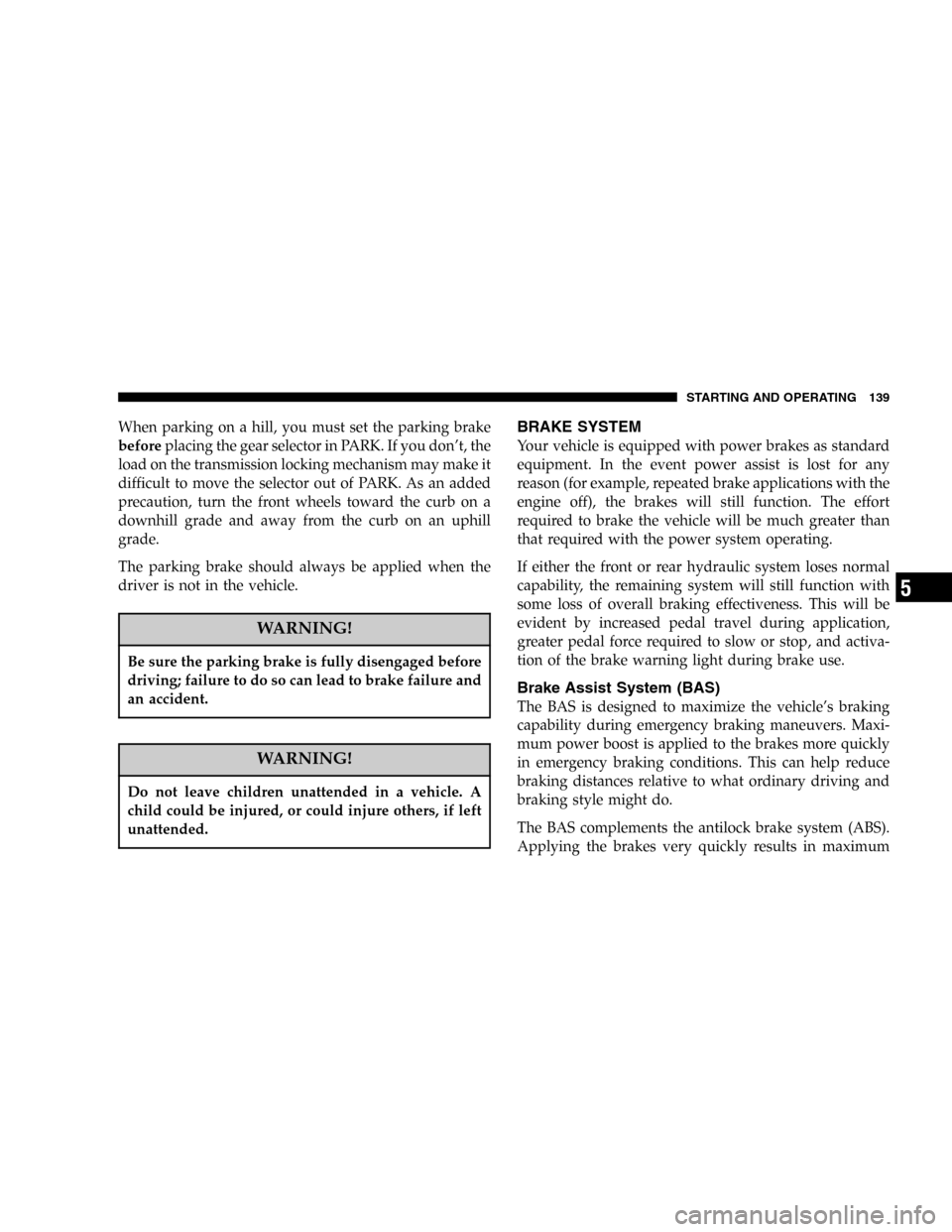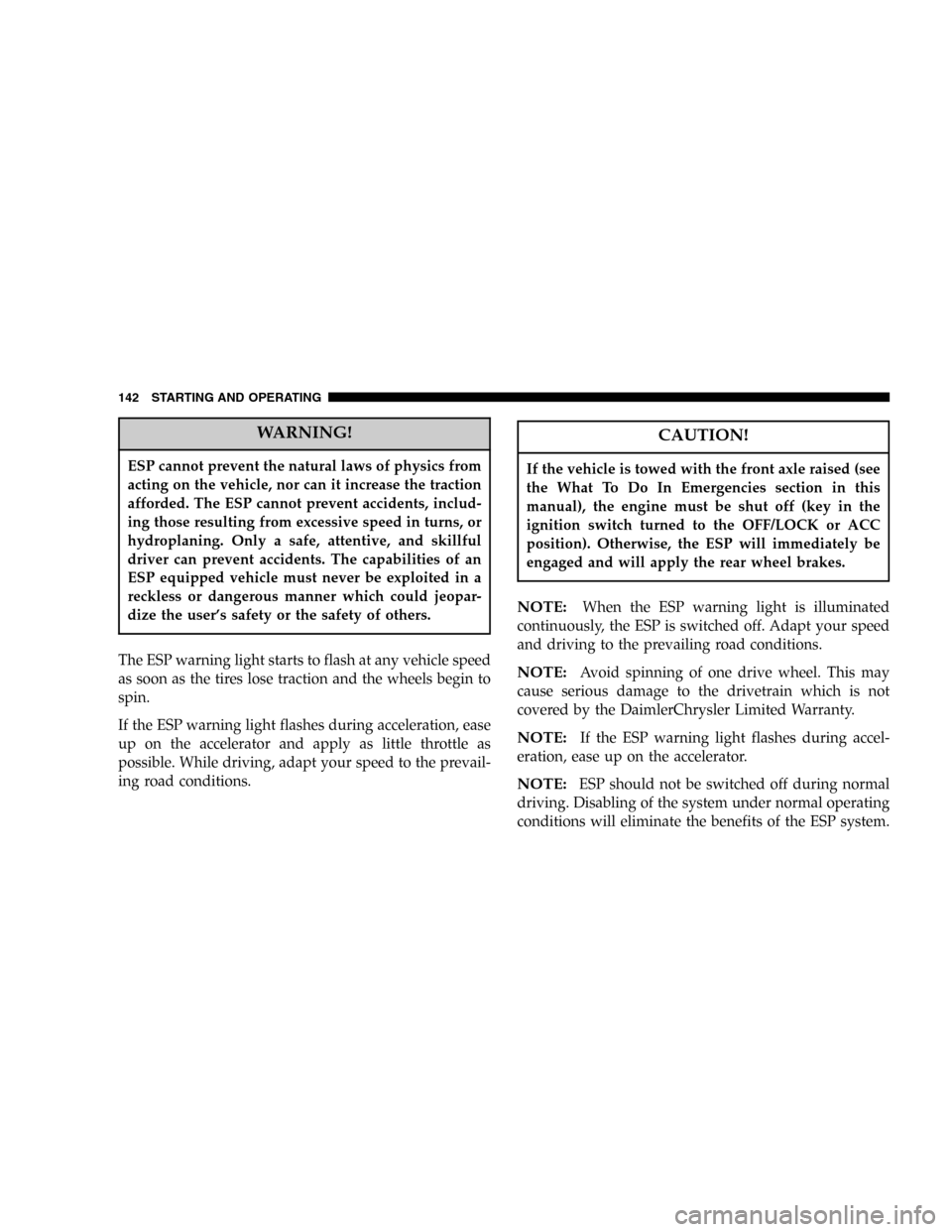Page 130 of 280

If Engine Fails to Start
CAUTION!
Do not try to push or tow your vehicle to get it
started. Your vehicle cannot be started this way.
Pushing with another vehicle may damage the trans-
mission or the rear of your vehicle. See Section 6 of
this manual for proper jump-starting procedures.
WARNING!
Never pour fuel or other flammable liquid into the
throttle body air inlet opening in an attempt to start
the vehicle. This could result in a flash fire, causing
serious personal injury.
If the engine fails to start after you have followed the
Normal Starting procedure, it may be flooded. Push theaccelerator pedal all the way to the floor and hold it there
while cranking the engine. This should clear any excess
fuel in case the engine is flooded.
CAUTION!
To prevent damage to the starter, do not crank the
engine for more than 15 seconds at a time. Wait 10 to
15 seconds before trying again.
If the engine has been flooded, it may start to run, but not
have enough power to continue running when the key is
released. If this occurs, continue cranking with the accel-
erator pedal pushed all the way to the floor. Release the
accelerator pedal and the key once the engine is running
smoothly.
If the engine shows no sign of starting after two 15-
second periods of cranking with the accelerator pedal
held to the floor, the Normal Starting procedure should
be repeated.
130 STARTING AND OPERATING
Page 134 of 280

the tool from the opening, the cover will not close fully.
Only after moving the selector lever to the“D+”and
“D-”positions does the cover return to its closed posi-
tion.
Reverse
Shift into REVERSE gear only when the vehicle is com-
pletely stopped.
Dependent on the program mode selector switch position
“S”or“W,”the maximum speed in the REVERSE gear is
different. However, it is not possible to change the
program mode while in REVERSE.
Neutral
No power is transmitted from the engine to the drive
axle. When the brakes are released, the vehicle can be
moved freely (pushed or towed). Do not engage in
NEUTRAL position while driving except to coast when
the vehicle is in danger of skidding (e.g., on icy roads).
NOTE:Coasting the vehicle, or driving for any other
reason with selector lever in NEUTRAL can result in
transmission damage that is not covered by the Limited
Warranty.
Drive
The transmission automatically upshifts through fifth
gear. The DRIVE position provides optimum driving
characteristics under all normal operating conditions.
AutoStick�Gear selection
The transmission gear can be selected by pressing the
selector lever to the right or the left with the selector lever
in the DRIVE position. The gear currently selected is
indicated in the instrument cluster display. Briefly press
selector lever in the“D-”direction. The transmission will
shift from the current gear to the next lower gear. Shifting
134 STARTING AND OPERATING
Page 136 of 280
Gear Ranges
“P”PARK
NOTE:If the key is in the ON/RUN position, you must
press the brake pedal to shift out of the PARK position.
PARK supplements the parking brake by locking the
transmission. The engine can be started in this range.
Never attempt to use PARK while the vehicle is in
motion.
Apply the parking brake when leaving the vehicle in this
range.
“R”REVERSE
Shift into this range only after the vehicle has come to a
complete stop.
“N”NEUTRAL
The engine may be started in this range. Use this range
for starting your vehicle if it is moving or being towed.“D”OVERDRIVE
This range should be used for most city and highway
driving. It provides the smoothest upshifts and down-
shifts and best fuel economy.
Program mode selector switch
The transmission is provided with a selector switch for
Standard“S”and Winter/Wet“W”(snow and ice) pro-
gram modes.
136 STARTING AND OPERATING
Page 139 of 280

When parking on a hill, you must set the parking brake
beforeplacing the gear selector in PARK. If you don’t, the
load on the transmission locking mechanism may make it
difficult to move the selector out of PARK. As an added
precaution, turn the front wheels toward the curb on a
downhill grade and away from the curb on an uphill
grade.
The parking brake should always be applied when the
driver is not in the vehicle.
WARNING!
Be sure the parking brake is fully disengaged before
driving; failure to do so can lead to brake failure and
an accident.
WARNING!
Do not leave children unattended in a vehicle. A
child could be injured, or could injure others, if left
unattended.
BRAKE SYSTEM
Your vehicle is equipped with power brakes as standard
equipment. In the event power assist is lost for any
reason (for example, repeated brake applications with the
engine off), the brakes will still function. The effort
required to brake the vehicle will be much greater than
that required with the power system operating.
If either the front or rear hydraulic system loses normal
capability, the remaining system will still function with
some loss of overall braking effectiveness. This will be
evident by increased pedal travel during application,
greater pedal force required to slow or stop, and activa-
tion of the brake warning light during brake use.
Brake Assist System (BAS)
The BAS is designed to maximize the vehicle’s braking
capability during emergency braking maneuvers. Maxi-
mum power boost is applied to the brakes more quickly
in emergency braking conditions. This can help reduce
braking distances relative to what ordinary driving and
braking style might do.
The BAS complements the antilock brake system (ABS).
Applying the brakes very quickly results in maximum
STARTING AND OPERATING 139
5
Page 142 of 280

WARNING!
ESP cannot prevent the natural laws of physics from
acting on the vehicle, nor can it increase the traction
afforded. The ESP cannot prevent accidents, includ-
ing those resulting from excessive speed in turns, or
hydroplaning. Only a safe, attentive, and skillful
driver can prevent accidents. The capabilities of an
ESP equipped vehicle must never be exploited in a
reckless or dangerous manner which could jeopar-
dize the user’s safety or the safety of others.
The ESP warning light starts to flash at any vehicle speed
as soon as the tires lose traction and the wheels begin to
spin.
If the ESP warning light flashes during acceleration, ease
up on the accelerator and apply as little throttle as
possible. While driving, adapt your speed to the prevail-
ing road conditions.
CAUTION!
If the vehicle is towed with the front axle raised (see
the What To Do In Emergencies section in this
manual), the engine must be shut off (key in the
ignition switch turned to the OFF/LOCK or ACC
position). Otherwise, the ESP will immediately be
engaged and will apply the rear wheel brakes.
NOTE:When the ESP warning light is illuminated
continuously, the ESP is switched off. Adapt your speed
and driving to the prevailing road conditions.
NOTE:Avoid spinning of one drive wheel. This may
cause serious damage to the drivetrain which is not
covered by the DaimlerChrysler Limited Warranty.
NOTE:If the ESP warning light flashes during accel-
eration, ease up on the accelerator.
NOTE:ESP should not be switched off during normal
driving. Disabling of the system under normal operating
conditions will eliminate the benefits of the ESP system.
142 STARTING AND OPERATING
Page 163 of 280
WARNING!
Cargo must be securely tied before driving your
vehicle. Improperly secured loads can fly off the
vehicle, particularly at high speeds, resulting in
personal injury or property damage. Follow the roof
luggage rack“Cautions”when carrying cargo on
your roof rack.
TRAILER TOWING
Trailer towing with your Crossfire is not recommended.
STARTING AND OPERATING 163
5
Page 165 of 280
WHAT TO DO IN EMERGENCIES
CONTENTS
�Hazard Warning Flasher.................166
�If Your Engine Overheats................166
�TIREFIT Tire Repair And Jacking..........167
▫TIREFIT............................167
▫Preparations For Jacking................170
▫Jack Location And Instructions............172
�Jump-Starting The Battery...............174
�Driving On Slippery Surfaces.............176▫Traction............................177
�Freeing A Stuck Vehicle.................177
�Towing A Disabled Vehicle...............178
▫Towing Eyes.........................179
▫Tow-Away Alarm.....................181
�Convertible Top Emergency Operation......182
▫Relieving Hydraulic Pressure.............183
6
Page 172 of 280
•Passengers must not remain in the vehicle when the
vehicle is jacked.
NOTE:The jack is designed exclusively for jacking up
the vehicle at the specified jack location points built
beneath either side of the vehicle.
Jack Location and Instructions
1. Remove the jack and jack handle from stowage be-
neath the cargo compartment carpet.2. The lifting points for the jack are located beneath the
outer edge of the body side, directly behind the front
wheel housings, and in front of the rear wheel housings.
172 WHAT TO DO IN EMERGENCIES